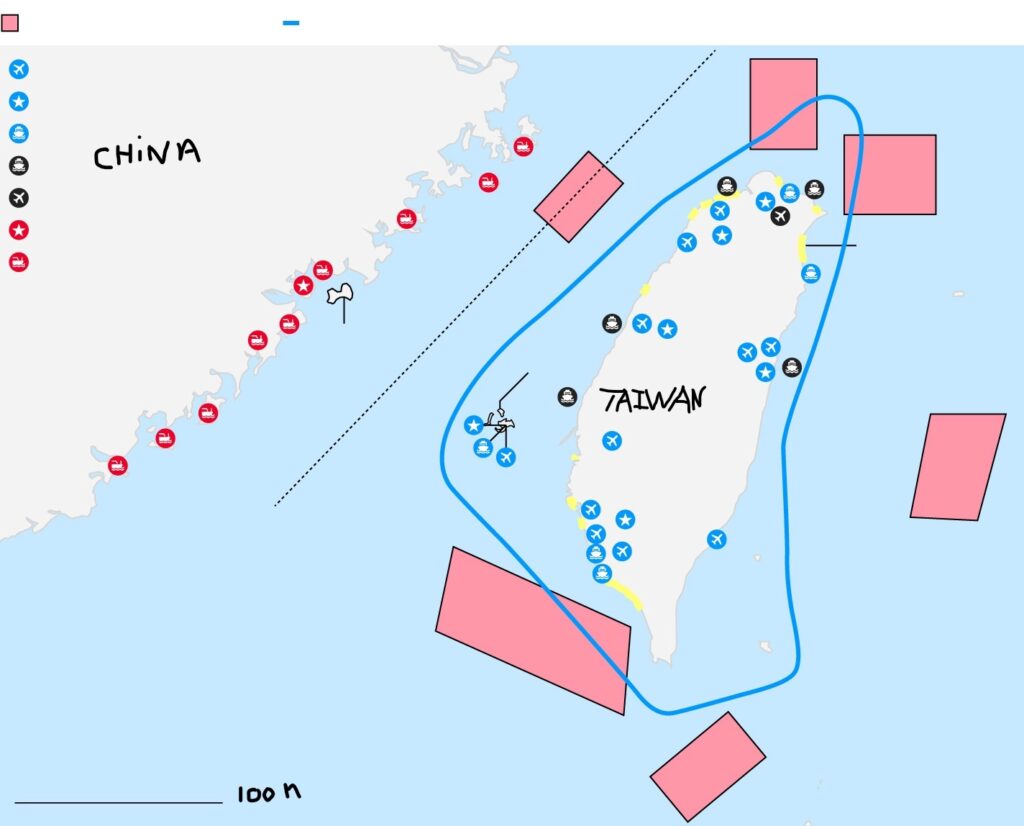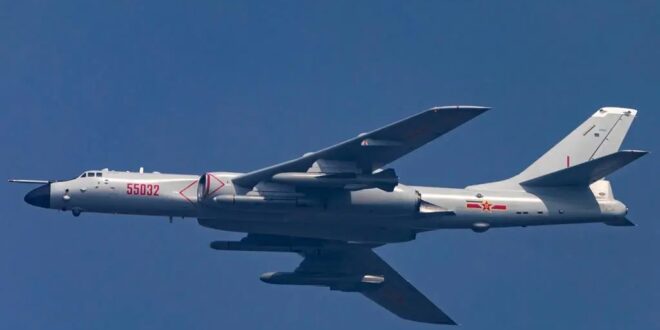Just as the second person in line for the US Presidency touched down in Taiwan the other day, the Chinese state-run news agency, Xinhua, released a map showing six boxed zones where their nation will be conducting war games not far from the coast of the disputed island nation.
A Sand Table

The blue line you see surrounding Taiwan marks its sovereign territorial waters. The red blocks are where the Chinese intend to conduct their live fire exercises. Marked on the shores of Taiwan, in yellow, is a shoreline suitable for landing large numbers of troops. It should be noted that not a lot of the coastline of Taiwan is suited for a large-scale assault. There are numerous areas where the water is too shallow or the coastline too rugged and rocky.
The dotted line you see running between the two nations is the “median line,” marking the halfway point between mainland China and Taiwan. Blue airplane icons denote Taiwanese air bases, those with a star are Taiwanese military bases, and those showing a ship are Taiwanese naval bases. Areas marked with a black icon are civilian airports and seaports. Off the western coast of Taiwan, we see Penghu County, a small island containing a Taiwanese military base, air base, and naval base.
On the red side, markers with a star denote Chinese military bases, and those with a ship icon are Chinese amphibious staging areas; prep areas for an invasion of the island nation.
Chinese Missiles
We’ll get the bad news out of the way first; according to FP (a foreign policy website), the entirety of Taiwan is within reach of China’s CSS-6, CSS-7, and CSS-11 short-range ballistic missiles. The Taiwan Strait (which separates mainland China from Taiwan, is only about 180 km wide). The range of the Dong Feng-15 is between 600 to 800 km.
Dong Feng launchers are mobile, and the projectiles are considered short-range surface-to-surface ballistic missiles. They can fire conventional, High Explosive, or nuclear warheads with a yield of up to 350 kilotons. As a point of reference, the nuclear weapons we dropped on Hiroshima yielded 16 kilotons.
Bombers
The Chinese Xian H-6 bomber is capable but based on an old Soviet design. It is based on the Tupolev Tu-16 twin-engine jet bomber that the Soviets delivered to China in 1958. The modern version, however, is capable of in-flight refueling and is armed with air-launched cruise missiles. The H-6K variant features a reinforced structure made of composite materials. According to Flight Global (FG), the newest variant, the H-6N, is capable of dropping nuclear munitions.
Malcolm Davis, a senior analyst, defense strategy and capability at the Australian Strategic Policy Institute, tells FG:
“The H-6N can carry China’s new Air-Launched Ballistic Missile (ALBM) derived from the DF-21D ASBM, which means it could launch such weapons from inside China’s anti-access, area-denial (A2/AD) envelope against US carrier battlegroups 809nm (1,500km) away, and well beyond the range of carrier-based air cover such as the [Lockheed Martin] F-35C.” The H-6N also carries the CM-401 short-range ALBM. It utilizes a “skip glide” technology that makes it tough to pick up on radar.
The Mighty Dragon
China’s most advanced jet fighter is the Chengdu J-20, given the badass nicked of “Mighty Dragon.”
According to Business Insider, the Dragon was introduced to the People’s Liberation Army Air Force in 2017. It is perhaps the most advanced weapon in the Chinese arsenal. The J-20 is a fifth-generation fighter, the third in that category (behind the American Lockheed Martin F-22 and F-35 fighters). The Eurasian Times reports, “Its fuselage, engine intake, and exhaust nozzle are identical to the F-22 and F-35.” It would not be the first time the Chinese “borrowed” technology from the United States. They claim, “The American XA100 engine that drives the F-35 is still at least ten years ahead of the WS-15″. That is the powerplant the J-20 utilizes.
Rotary Winged Aircraft
Above, we get a good view of China’s Z-10 (aka WZ-10) attack helicopters in action. Look closely; they might seem to be a bit familiar. That’s likely because their design and functionality have largely been “borrowed” from our own tried and true Apache helicopter. Global Times (GT) reports that the aircraft has a range of 1,120 km and an empty weight of roughly 5,100 kg. It has four external hard points that can carry rockets or air-to-ground missiles. It is also armed with a 23 mm revolving cannon.
The Z-10 was designed primarily as an anti-tank platform but also to perform a secondary function of air-to-air combat. GT tells us that they can carry as many as 16 anti-tank missiles or four each 7 barrel multiple rocket launchers.
And Much, Much More
The weapons mentioned above are, of course, but a tiny fraction of the Chinese arsenal that they no doubt will be bringing out for these war games.
Expect to see field artillery, multiple rocket launcher systems (MLRS), anti-aircraft artillery, various drones, tanks, armored personnel carriers, and lots of and lots of ground-pounding foot soldiers, as shown above.
This exercise is an excuse for China to flex its muscles to the world, and I believe they will take every opportunity to do so.
 Eurasia Press & News
Eurasia Press & News




